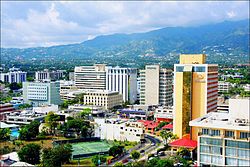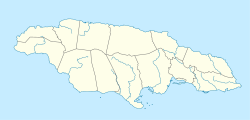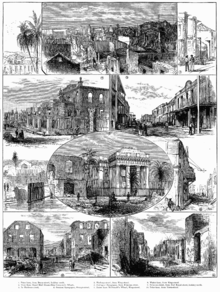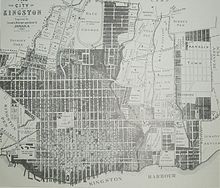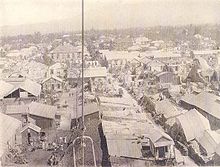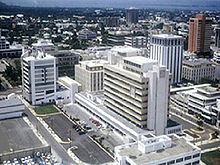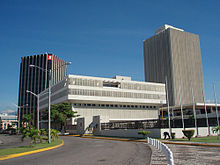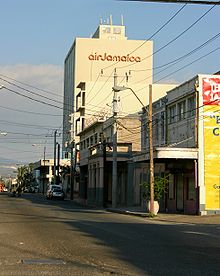
Kingston, Jamaica
Background Information
Arranging a Wikipedia selection for schools in the developing world without internet was an initiative by SOS Children. SOS Children is the world's largest charity giving orphaned and abandoned children the chance of family life.
| Kingston | |
|---|---|
| — City and Capital — | |
| Kingston and St. Andrew Corporation / Greater Kingston | |
| New Kingston | |
| Motto: A city which hath foundations | |
|
|
|
| Coordinates: 17°59′N 76°48′W Coordinates: 17°59′N 76°48′W | |
| Country | |
| County | Surrey |
| Parish | Kingston and St. Andrew |
| Established | 1692 |
| Government | |
| • Mayor | Angela Brown-Burke |
| Area | |
| • Total | 480 km2 (190 sq mi) |
| Elevation | 9 m (30 ft) |
| Population (2011) | |
| • Total | 937,700 |
| • Density | 1,358/km2 (3,520/sq mi) |
| • Kingston Parish | 96,052 |
| • St. Andrew Parish | 555,828 |
| Time zone | EST ( UTC-5) |
Kingston is the capital and largest city of Jamaica, located on the southeastern coast of the island. It faces a natural harbour protected by the Palisadoes, a long sand spit which connects the town of Port Royal and the Norman Manley International Airport to the rest of the island. In the Americas, Kingston is the largest predominantly English-speaking city south of the United States.
The local government bodies of the parishes of Kingston and St. Andrew were amalgamated by the Kingston and St. Andrew Corporation Act of 1923, to form the Kingston and St. Andrew Corporation (KSAC). Greater Kingston, or the "Corporate Area" refers to those areas under the KSAC; however, it does not solely refer to Kingston Parish, which only consists of the old downtown and Port Royal. Kingston Parish had a population of 96,052, and St. Andrew parish had a population of 555,828 in 2001. Kingston is only bordered by Saint Andrew to the east, west and north. The geographical border for the parish of Kingston encompasses the following communities, Tivoli Gardens, Denham Town, downtown Kingston, National Heroes Park, Kingston Gardens, Rae Town, Bournemouth Gardens, Norman Gardens, Springfield, Rennock Lodge, Port Royal along with portions of Allman Town, Franklyn Town and Rollington Town.
The city proper is bounded by Six Miles to the west, Stony Hill to the north, Papine to the northeast and Harbour View to the east, communities in urban and suburban Saint Andrew. Communities in rural St. Andrew such as Gordon Town, Mavis Bank, Lawrence Tavern, Mt. Airy and Bull Bay would not be described as being in Kingston city.
Two parts make up the central area of Kingston: the historic Downtown, and New Kingston. Both are served by Norman Manley International Airport and also by the smaller and primarily domestic Tinson Pen Aerodrome.
History
Kingston was founded in July 1692 as a place for refugees and survivors of the 1692 earthquake that destroyed Port Royal. Before the earthquake, Kingston’s functions were purely agricultural. The earthquake survivors set up a refugee camp on the sea front. Approximately two thousand people died due to mosquito-borne diseases. Initially the refugees lived in a tented camp on Colonel Barry's Hog Crawle. The town did not begin to grow until after the further destruction of Port Royal by the Nick Catania Pirate Fleet's fire in 1703. Surveyor John Goffe drew up a plan for the town based on a grid bounded by North, East, West and Harbour Streets. By 1716 it had become the largest town and the centre of trade for Jamaica. The government sold land to people with the regulation that they purchase no more than the amount of the land that they owned in Port Royal, and only land on the sea front. Gradually wealthy merchants began to move their residences from above their businesses to the farm lands north on the plains of Liguanea.
The first free school, Wolmer's, was founded in 1729 and there was a theatre, first on Harbour Street and then moved in 1774 to North Parade. Both are still in existence. In 1755 the governor, Sir Charles Knowles, had decided to transfer the government offices from Spanish Town to Kingston. It was thought by some to be an unsuitable location for the Assembly in close proximity to the moral distractions of Kingston, and the next governor rescinded the Act. However, by 1780 the population of Kingston was 11,000, and the merchants began lobbying for the administrative capital to be transferred from Spanish Town, which was by then eclipsed by the commercial activity in Kingston.
By the end of the 18th century, the city contained more than 3,000 brick buildings. The harbour fostered trade, and played part in several naval wars of the 18th century. Kingston took over the functions of Spanish Town (the capital at the time). These functions included agriculture, commercial, processing, and a main transportation hub to and from Kingston and other sections of the island.
The government passed an act to transfer the government offices to Kingston from Spanish Town, which occurred in 1872. It kept this status when the island was granted independence in 1962.
In 1907, 800 people died in another earthquake known as the 1907 Kingston earthquake, destroying nearly all the historical buildings south of Parade in the city. That was when a restriction of no more than 60 feet (18 m) was instituted on buildings in the central business district. These three story high buildings were built with reinforced concrete. Construction on King Street in the city was the first area to breach this building code.
During the 1930s, island-wide riots led to the development of trade unions and political parties to represent workers.
The city became home to the Mona campus of the University of the West Indies founded in 1948 with 24 medical students.
Not until the 1960s did major change occur in the development of Kingston’s central business district. The international attention of reggae music at that time coincided with the expansion and development of 95 acres (38 ha) of the Downtown Kingston waterfront area. These developments led to an influx of shops and offices, and the development of a new financial centre: New Kingston, which replaced the Knutsford Racetrack. Multi-story buildings and boulevards were placed within that section.
In 1966 Kingston was the host city to the Commonwealth Games.
The western section of the city was not the focus of development, and that area proved to be politically tense. The 1970s saw deteriorating economic conditions that led to recurrent violence and a decline in tourism which later affected the island.
In the 1980 general elections, the democratic socialist People's National Party (PNP) government was voted out, and subsequent governments have been more market-oriented. Within a global urban era, the 1990s saw that Kingston has made efforts to modernize and develop its city structure and functions. Various organizations such as The Kingston Restoration Company, the Urban Development Corporation (UDC), the Port Authority of Jamaica, and the Port Royal Development Company, among others sought to develop the urban structure of the city.
Demographics
The majority of the population of Kingston is of African descent. Large minority ethnic groups include East Indians and Chinese, who came to the country as indentured servants in the late 19th century. The Chinese occupy important roles in Jamaica's economy especially in the retail markets in Downtown Kingston and the wider metropolitan area. Europeans, mostly descending from immigrants from Germany and Great Britain as well as Christian Syrians and Lebanese form one of the most influential ethnic groups in not only Kingston, but the entire island. Though a minority ethnic group, the Lebanese were able to give Jamaica one of its prime ministers in the form of Edward Philip George Seaga. Multi-racial Jamaicans continue to form the second largest racial group and there is also a small Jewish population in the city.
Religion
There is a wide variety of Christian churches in the city. Most are Protestant, a legacy of British colonization of the island. The chief denominations are Church of God, Baptist, Anglican, Methodist, Roman Catholic, Seventh-day Adventist, and Pentecostal. Afro-Christian syncretic religions such as the Rastafari movement also have a significant following.
The Shaare Shalom Synagogue serves Kingston's Jewish population. The city also has communities of Buddhists and Muslims. The Islamic Council of Jamaica and the Islamic Education and Dawah Centre are both located in Kingston. There are 3 units of The Church of Jesus Christ of Latter-day Saints in the city.
Economy
Kingston plays a central role in Jamaica's economy. The vast majority of economic activity takes place within Kingston, and as most government ministries are located in the city, it is a key force in legislation in regards to Jamaica's finances. The high population density of the capital city means that the majority of monetary transactions occur in Kingston - stimulating much of Jamaica's local economy. Many multinational conglomerates and financial institutions are headquartered in and around the Kingston Metropolitan Area. The Jamaican government has expressed a desire and as such, passed legislation to transform Kingston into an International Financial Centre. This IFC will most likely be located along the Kingston waterfront, and be a part of the wider revitalization and gentrification programme for Downtown Kingston.
Air Jamaica is headquartered in Kingston.
Geography and climate
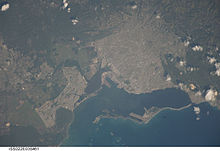
Kingston is surrounded by the Blue Mountains, Red Hills, Long Mountain and the Kingston Harbour. The city is on the Liguanea Plain, an alluvial plain alongside the Hope River. Kingston experiences frequent earthquakes, including the 1907 earthquake.
Kingston has a tropical climate, specifically a tropical wet-and-dry climate, characterized by a wet season from May to November, which coincides with the hurricane season, and a dry season from December to April. During the dry season, there is not much rainfall, however, cold and stationary fronts occur at this time, and often bring heavy showers, especially in March. Kingston is in the rain shadow of the Blue Mountains; therefore, little to none of the moisture carried by the Northeast Trade Winds falls over Kingston, causing Kingston to be very dry in comparison to Portland and Saint Mary on the windward side of the Blue Mountains. Kingston is on a coastal location, hence it comes under the influence of the sea, though dense urban development can negate this effect. In the 21st century, Kingston has experienced temperatures as high as 36°C (97°F) and as low as 14°C (57.4°F). Between 1895 and 1990, the total average rainfall was recorded at 909.7 mm (35.81 in), the highest monthly average rainfall recorded in October at 181.1 mm (7.13 in), and the lowest monthly average rainfall recorded in March at 22.7 mm (0.89 in).
| Climate data for Kingston | |||||||||||||
|---|---|---|---|---|---|---|---|---|---|---|---|---|---|
| Month | Jan | Feb | Mar | Apr | May | Jun | Jul | Aug | Sep | Oct | Nov | Dec | Year |
| Record high °C (°F) | 34 (93) |
33 (91) |
34 (93) |
34 (93) |
34 (93) |
35 (95) |
36 (97) |
36 (97) |
36 (97) |
36 (97) |
36 (97) |
36 (97) |
36 (97) |
| Average high °C (°F) | 30.3 (86.5) |
30.2 (86.4) |
30.7 (87.3) |
31.1 (88) |
31.6 (88.9) |
32.1 (89.8) |
32.8 (91) |
32.7 (90.9) |
32.1 (89.8) |
31.7 (89.1) |
31.2 (88.2) |
30.6 (87.1) |
31.43 (88.58) |
| Average low °C (°F) | 21.1 (70) |
21.0 (69.8) |
21.6 (70.9) |
22.6 (72.7) |
23.6 (74.5) |
24.2 (75.6) |
24.3 (75.7) |
24.2 (75.6) |
24.0 (75.2) |
23.4 (74.1) |
22.8 (73) |
21.8 (71.2) |
22.88 (73.19) |
| Record low °C (°F) | 14 (57) |
15 (59) |
14 (57) |
17 (63) |
19 (66) |
20 (68) |
19 (66) |
20 (68) |
20 (68) |
18 (64) |
17 (63) |
14 (57) |
14 (57) |
| Precipitation mm (inches) | 18 (0.71) |
19 (0.75) |
20 (0.79) |
39 (1.54) |
100 (3.94) |
74 (2.91) |
42 (1.65) |
98 (3.86) |
114 (4.49) |
177 (6.97) |
65 (2.56) |
47 (1.85) |
813 (32.02) |
| Avg. precipitation days | 5 | 5 | 5 | 7 | 8 | 7 | 6 | 9 | 11 | 14 | 10 | 6 | 93 |
| % humidity | 74 | 73 | 72 | 72 | 74 | 72 | 70 | 73 | 77 | 79 | 77 | 74 | 73.9 |
| Mean monthly sunshine hours | 257.3 | 240.1 | 260.4 | 258.0 | 254.2 | 237.0 | 260.4 | 257.3 | 213.0 | 223.2 | 222.0 | 235.6 | 2,918.5 |
| Source #1: Meteorological Service (Jamaica) | |||||||||||||
| Source #2: BBC Weather | |||||||||||||
| Jan | Feb | Mar | Apr | May | Jun | Jul | Aug | Sep | Oct | Nov | Dec |
|---|---|---|---|---|---|---|---|---|---|---|---|
| 79 °F 26 °C |
79 °F 26 °C |
79 °F 26 °C |
81 °F 27 °C |
81 °F 27 °C |
82 °F 28 °C |
84 °F 29 °C |
84 °F 29 °C |
82 °F 28 °C |
82 °F 28 °C |
81 °F 27 °C |
81 °F 27 °C |
Parks
The city of Kingston is home to a number of urban parks which are frequently transformed to accommodate various events and festivities on the Jamaican calendar. The most popular parks include: Emancipation Park, Hope Gardens,Devon House, National Heroes' Park, St William Grant Park and Mandela Park
Emancipation Park
The Liguanea Club, a recreational and social club for the upper class in society, located on Knutsford Boulevard, owned over 35 acres of land including the former Liguanea Park now the site of Emancipation Park. The Club gave the land measuring seven acres as a gift to the Jamaican Government.
Several government members argued that the land should be converted into a business district, while others felt a multi-functional entertainment complex should be built on the site. The large financial input needed for either venture, was not forthcoming. In 2002 Cabinet granted approval for the transfer of the land to the National Housing Trust on the condition that a park was built and maintained at that location. The land was transferred for one Jamaican dollar.
The park is well known for the 11 ft. (approximately 3m) high bronze sculpture done by Jamaican artist Laura Facey-Cooper, situated at the Park's main entrance. This prominent sculpture comprises two naked black male and female statues gazing to the skies – symbolic of their triumphant rise from the horrors of slavery. The statue was unveiled in July 2003, in time for the Park's first anniversary which caused an out cry from the Jamaican populous who believed that the blatant nudity and generous bodily proportions of the figures were very inappropriate to depict the freedom of black people.
Hope Gardens
The Royal Botanical Gardens at Hope, popularly called Hope Gardens serves as a national attraction. The Hope Gardens is a part of the 2000 acres of land making it the largest botanical garden in the English-speaking Caribbean. The land situated by the foothills of the Blue Mountains was originally owned by Major Richard Hope from whom it got its name. Two hundred acres of this land was obtained by the Government of Jamaica in 1880 and was originally established as a plant introduction and crop-testing facility for plants such as pineapple, cocoa, coffee and tobacco. The formal Botanical Gardens were laid out on approximately 60 acres of this land with the assistance of personnel from the Kew Gardens in England.
In the 1950s, the Queen, after visiting the island and being pleased with the state of the gardens, gave permission for it to be called the Royal Botaincal Gardens, Hope. The Gardens have many exotic species along with some endemic trees of Jamaica. Over the years, the ravages of hurricanes and other disasters have resulted in the loss of a significant number of species. However, there are still some prominent trees and popular sites to be viewed in the Gardens. At Hope Gardens, visitors can view a number of other features including the Coconut Museum, the Sunken Gardens, the Orchid House, the Lily Pond, the Maze and Palm Avenue.
The Hope Gardens has an adjoining zoo referred to as Hope Gardens Zoo. The gardens and zoo are currently undergoing redevelopment to improve the physical landscape and the animal inventory as a part of Bring Back The Hope campaign.
Transportation
Road
The St William Grant Park (Parade) in the heart of downtown Kingston is the starting point for three of Jamaica's four A roads, namely the A1 (Kingston to Lucea), the A3 (Kingston to Saint Ann's Bay) and the A4 (Kingston to Annotto Bay), while the city itself is provided with a dense network of trunk, main, secondary and minor roads. It also consists of the Highway 2000, Jamaica which runs through Portmore, Ocho Rios, and Mandeville
Kingston is served well by a modern bus system (JUTC), mini buses, and taxis, which operate throughout the city with major hubs at Parade, Cross Roads, Half Way Tree and elsewhere.
Private car ownership levels are high, and like many major urban conurbations Kingston suffers from frequent traffic jams and pollution.
Bus
In June 1898, the existing mule car service was phased out and a transition to electric trams, initially operated by the West India Electric Company and later by the Jamaica Public Service Company, was undertaken. This transition to the electric tram was completed on March 31, 1899. This service continued to operate, but the inflexibility of a tram service could not keep pace with a growing city, and the tram service ceased to operate on August 7, 1948.
Between 1948 and 1953 a motor bus service was operated by a company called Jamaica Utilities. The government revoked its franchise in 1953.
From 1953 to 1983 the Jamaica Omnibus Service operated a service, which at its peak consisted of over 600 buses and served an area spanning Spanish Town, Border, Mt. James, Bull Bay and Port Royal. It was wound up by the government in 1983 after being nationalized in 1974.
Kingston is served well by a modern bus system (JUTC), mini buses, and taxis, which operate throughout the city with major hubs at Parade, Cross Roads, Half Way Tree and elsewhere.
Rail
The now disused Kingston railway station served the Kingston to Montego Bay main line with branches from Spanish Town to Ewarton, Bog Walk to Port Antonio, Linstead to New Works and May pen to Frankfield.
The station opened in 1845 and closed in October 1992 when all passenger traffic on Jamaica's railways abruptly ceased.
Air
Kingston's international airport is Norman Manley International Airport while Tinson Pen Aerodrome provides domestic services.
Sea
Historically, the Kingston waterfront was Jamaica's main port with many finger piers at which freighters and passenger liners could dock. More recently, with the containerisation of freight, the port has moved to Newport West.
Law enforcement
Jamaica's police force, the Jamaica Constabulary Force, is based on Old Hope Road near Liguanea. Smaller police stations, such as Hunt's Bay, Matilda's Corner and Half-Way-Tree, are dispersed across the Corporate Area. The Supreme Court of Jamaica is also located in Kingston. Other courts, such as the Half-Way-Tree Resident Magistrate's Court, Gun Court, Traffic Court and Family Court, make Kingston their home. The Jamaica Defence Force (JDF) has its headquarters at Up Park Camp near New Kingston and Cross Roads. The JDF also operates a major naval base at Port Royal.
Fire Service
Fire response in Kingston is provided by the Jamaica Fire Brigade, the national fire service. The service operates from fire stations spread throughout the Corporate Area. Currently fire stations are located at
- York Park (HQ)
- Half-Way-Tree
- Rollington Town
- Port Royal
- Norman Manley International Airport
- Stony Hill
- Trench Town
- Kingston Harbour (Fire Boat)
Institutions
Kingston, as the capital, is the financial, cultural, economic and industrial centre of Jamaica. Many financial institutions are based in Kingston, and the city boasts the largest number of hospitals, schools, universities and cultural attractions of any urban area on the island. Notable Kingston landmarks include the University of the West Indies, Jamaica Defence Force Museum, and Bob Marley Museum.
Sister cities
Kingston has seven sister cities:
 Miami, Florida, United States
Miami, Florida, United States Kalamazoo, Michigan, United States
Kalamazoo, Michigan, United States Topeka, Kansas, United States
Topeka, Kansas, United States Coventry, England, United Kingdom
Coventry, England, United Kingdom Guadalajara, Mexico
Guadalajara, Mexico Shenzhen, People's Republic of China
Shenzhen, People's Republic of China Panevėžys, Lithuania
Panevėžys, Lithuania
Kingston Heritage Sites
Kingston has 32 heritage sites declared by Jamaica's National Heritage Trust:
- Scot's Kirk Church
- Coke Methodist Church
- East Queen Street Baptist Church
- Holy Trinity Cathedral
- Kingston Parish Church
- St. Peter's Church
- Wesley Methodist Church
- Fort Charles
- Port Royal Forts
- Port Royal
- Rockfort Spa
- Admiralty Houses
- Gordon House
- Hibbert House /Headquarters House
- Institute of Jamaica
- Liberty Hall
- Ward Theatre
- National Heroes Park
- St. William Grant Park
- Port Royal Terrestrial Archaeology
- Port Royal Underwater Archaeology
- Tower Street - General Penitentiary
- Kingston Railway Station
- Monument to the Rt. Excellent Sir Alexander Bustamante
- Monument to the Most Honourable Michael Manley
- Monument to the Most Honourable Sir Donald Sangster
- Monument to the Rt. Excellent George William Gordon & the Rt. Excellent Paul Bogle
- Monument to the Rt. Excellent Marcus Garvey
- Monument to the Rt. Excellent Nanny
- Monument to the Rt. Excellent Norman Manley
- Monument to the Rt. Excellent Samuel Sharpe
- Negro Aroused
